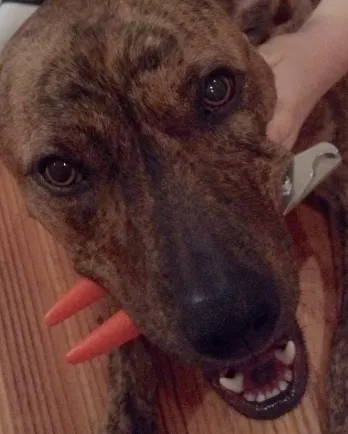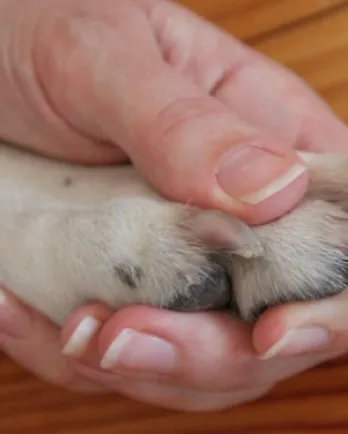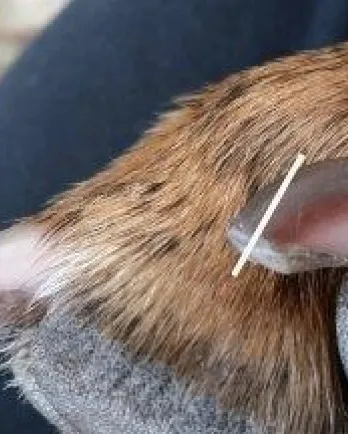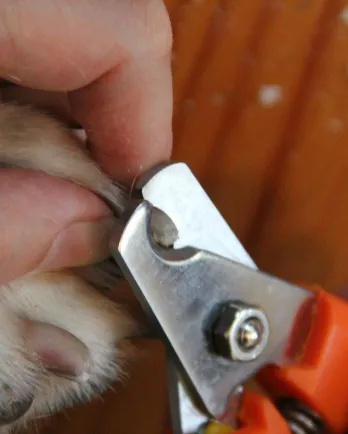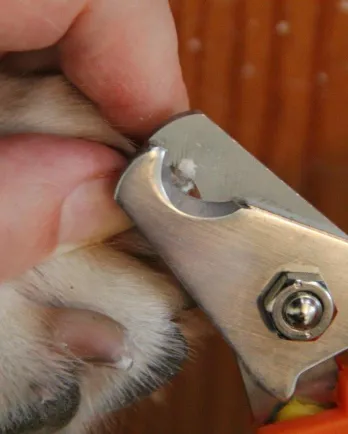Recipe for Short Dog Nails by Dr. Julie Buzby, DVM
Dr. Julie Buzby, DVM, a member of Grey Muzzle's Advisory Board, is a practicing integrative veterinarian who seeks to blend the best of Western medicine, alternative therapies, and creative tools for maximum wellness in her patients. She is also the developer of ToeGrips®, devices that improve mobility in dogs by providing them with better traction. She has published numerous articles on canine health and wellness, and has a new blog, The Buzby Bark. You can also find more of her articles for Grey Matters here.
Proper nail care is important for the health and mobility of all dogs (and senior dogs, in particular), but can be a dog guardian's least favorite task. To show that it needn't be a source of dread, Dr. Buzby shares with us her special "recipe" for safely and painlessly trimming a dog's nails.
Preparation Time: 15 minutes
If your dog is not particularly cooperative about having his/her nails trimmed, remember the old adage, “A tired dog is a good dog.” Grab a leash and take your four-legged pal for a spin. Draining excess energy will take the edge off and help the procedure go more smoothly.
Recommended Tools:
I recommend using a large, well-designed nail clipper that resembles a mini pruning shear. Never use a “guillotine” style trimmer because they are designed for a “one snip fits all” type of nail trim which is suboptimal in both efficacy and safety. It is probably also wise to have a bottle of styptic powder on hand, though with vigilance and good observational skills, you should never need it.
Directions:
Step 1: Your nail-trimming team
Find the most comfortable position for your dog to rest that allows you to work on his paws. For a big dog, this may be lying on the side. For a little dog, this may mean having an assistant snuggle the dog against the human’s chest. Other ideas include having the dog “recline” in an armchair beside you with legs sticking out front, being held in a standing person’s arms, or lying on a person’s lap. Whatever the position, it’s unlikely the dog will be 100% perfectly cooperative, but you want to chose a position that is visibly comfortable for the dog and not fear-inducing. Above all, we need to keep this experience positive, because you will (ideally) repeat it routinely.
For a dog who is absolutely petrified of having his/her nails trimmed, I consider the procedure to be a 4-person job. And this is why success may require a visit to the vet hospital, because they can pull together a team of 3 or 4 experienced animal handlers lightning quick. My 4-person nail trim team looks like this:
- one person holding/supporting/restraining the dog on the front end;
- one person holding/supporting/restraining the dog on the hind end and also pleasantly scratching the hindquarters for distraction;
- one person rubbing the dog’s head with vigor, speaking kind words, and offering every manner of moral support. I really can’t stress how important positive distraction is for these dogs!
- one person trimming the nails.
A 2-or-3-person nail trim would be a modified technique of the above, and the one-person nail trim is possible when the dog is super cooperative and no assistant is needed. The dog rests respectfully, while you, the sole human participant, trim the nails.
Step 2: Getting into position
Gently hold and support each paw as you work on the nails. Dogs don’t like to feel vulnerable. Whether it be in the restraint of the whole dog or the handling of the paws, if you let the dog feel like he has a lot of room to squirm, thrash, and eventually flee, you’ve just reinforced the idea that fighting for an escape is the optimum behavior. Gently-yet-confidently taking the lead in the situation will inspire your dog to comply.
Food for thought:
Sometimes a dog will repeatedly pull back a fore or hind leg while you are trying to trim the nails. If the person helping to hold the dog grabs the leg and puts it in a death grip, the dog will fight all the more. Guaranteed. Ultimately, you want control of the leg both so you can trim the nails on a stationery target, and more importantly, so your dog does not injure himself jerking the leg back and forth.
This is where understanding the dog’s anatomy comes in handy. Instead of using brute force, I recommend finesse. When working with a forelimb, simply take the palm of your hand and “lock out” the elbow joint by placing the palm firmly against the back of the extended elbow at the bony protuberance (called the olecranon) and press forward (toward the head).
Now your dog can’t bend the leg. It’s locked out in extension, which makes it much safer for everyone involved. It’s a “less is more” approach that often is the best approach when working with animals.
When working with a hind leg, you can do something similar. Use the palm of your hand in front of the dog’s knee (the joint below the hip on the hind leg) and gently press backwards (toward the tail) to lock out the hind limb in extension. Using this biomechanical advantage, along with another hand to support the length of the limb, stability can be achieved in a minimally obtrusive way.
Step 3: Let’s get cooking!
Trimming the nails can be very intimidating, but this need not be the case. When you give directions to a destination, you might include landmarks, such as turn left at the big pink hotel. Similarly, when trimming the nails, there are landmarks you can watch for to make sure you get where you need to go without veering off course and having an accident.
The goal: Our objective is to trim the nail back as near to the quick as possible without hitting it. The quick is the nerve and blood supply, which run together through the “live” part of the nail. The “dead” part of the nail has no nerve and blood supply and should be trimmed off much like we trim our own nails.
The technique: Traditional wisdom holds that we cut the nail at an angle which is almost parallel to the ground, and snip off the nail tip accordingly. We’re going to spice up this recipe by casting tradition aside. Instead of making your cut horizontal, I recommend making the cuts very vertical—actually past the vertical.
In this way, you are removing extra nail (that your dog would otherwise have to “break over” with every stride), while avoiding the quick, which runs lower in the nail. Here’s a video demo of this with our family dog, Luke: Nail Trimming Tutorial with Dr. Buzby
Step by step directions:
- Gently hold the paw in your non-dominant hand (i.e., left for most of us), and support each toe as you work.
- Grasp the nail trimmers in your dominant hand and make a “vertical” cut.
- For a light-colored nail, you can visualize the quick and then eyeball where to make that cut.
- For a dark nail, you cannot see the quick. Fear not. Start conservatively, near the tip, and proceed to make multiple sliver cuts until you begin to see the “pre-quick”.
- For a light-colored nail, the “pre-quick” is pinkish-beige.
- For a dark-colored nail, the “pre-quick” is dark black and reminds me of black licorice.
- As the “pre-quick” becomes visible, stop making cuts to remove nail length, because we don’t want to get any closer to the nerve and blood supply. Cutting the quick causes bleeding and significant pain.
- Now, focus on “sculpting” the edges of the nail—the sharp corners on either side of the nail that have been formed as you’ve been making cuts. Trimming these sides should not make the nail functionally shorter and thus not risk you cutting into the quick.
Repeat these steps for all 16 nails (and dewclaws, if applicable).
Yield: 16 short nails and a dog with instantly improved posture and gait!
Season to taste (AKA personal preference): Dremeling is a perfectly wonderful technique that works well for many dogs. However, I like the overall simplicity of using nail trimmers. It’s just my personal preference.
You can find more articles by Dr. Julie Buzby on her new blog, The Buzby Bark.
The information presented by The Grey Muzzle Organization is for informational purposes only. Readers are urged to consult with a licensed veterinarian for issues relating to their own pet's health or well-being or prior to implementing any treatment.
The Grey Muzzle Organization improves the lives of at-risk senior dogs by providing funding and resources to animal shelters, rescue organizations, sanctuaries, and other nonprofit groups nationwide.


